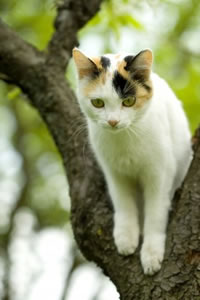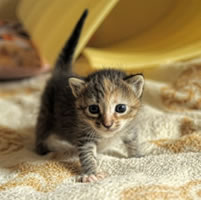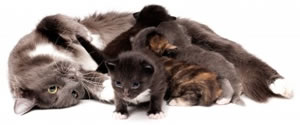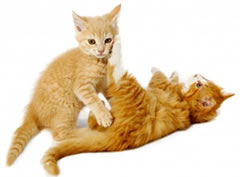18% of reported animal abuse cases are cat abuse, as of Dec. 6th, 2012 there have been 3,335 reported cases of Cat Abuse
 Domestic cats have been around for some where between 4000 -8000 years. Unlike dogs, cats were not domesticated to provide specific labor although they are often used to catch and kill vermin. Considered beautiful and elegant creatures, there are not as many individual cat pedigree breeds as dogs and cat personalities and behaviors do not vary as widely. However, there can be distinct differences between cats depending upon their environment, their level of socialization, if they live in an environment with multiple cats and their maternal influence.
Domestic cats have been around for some where between 4000 -8000 years. Unlike dogs, cats were not domesticated to provide specific labor although they are often used to catch and kill vermin. Considered beautiful and elegant creatures, there are not as many individual cat pedigree breeds as dogs and cat personalities and behaviors do not vary as widely. However, there can be distinct differences between cats depending upon their environment, their level of socialization, if they live in an environment with multiple cats and their maternal influence.
Cats communicate primarily through body language, although there are many breeds that are exceedingly vocal (Siamese cats are notoriously loud). Tail flicking, rubbing, and purring are common methods cats use to communicate various moods and needs. Spraying is also a highly common (and annoying) instinct, wherein a cat sprays small amounts of urine to mark their territory if they feel threatened by other animals or strange humans. Cats will also rub their scent against objects or people in order to claim ownership. Cats have pheromones in their urine and in glands in their cheeks, tails and their claws, so when they spray, rub or kneed, they are depositing hormones that are detectible to other cats. Neutered cats typically do not spray, although males that were neutered late in life might continue on occasion.
Cats that have been socialized as kittens with different humans and animals can exhibit almost dog-like friendliness as adults. It is not uncommon to see a cat pant, fetch and play like dogs when it has been socialized with friendly and affectionate animals and humans. Kittens that have been socialized starting at the age of roughly four months have a better chance of integrating with new people and pets as adults; the older the cat is before socialization, the more likely it is to be frightened by and hostile towards strangers. If you are introducing an adult cat into a home that already has cats in residence, it is important to know if that cat came from a neglectful or abusive environment, because that cat might be a danger to the other animals and even humans.
If you are considering adopting an unsocialized or feral cat, you must be very patient and careful, and let the cat dictate the pace of integration. If done slowly and properly, even an emotionally delicate cat can become a loving and friendly companion.
Feeding
Cats are notoriously finicky eaters; they don’t care for sweets or salt and they only eat fresh food and drink fresh water. Feeding cats isn’t really a tricky business, so long as attention is paid to the cat’s age, level of activity and health requirements.
 It is commonly believed that wet (canned) cat food is better for cats than dry. This may be true if the cat is prone to dehydration, since wet cat food is between 50% and 70% water. Actually, dry cat food is more nutritionally dense than wet, and certainly less expensive. However, in the wild, cats eat small animals, and the moisture content of wet cat food mimics that of the prey they would naturally eat.
It is commonly believed that wet (canned) cat food is better for cats than dry. This may be true if the cat is prone to dehydration, since wet cat food is between 50% and 70% water. Actually, dry cat food is more nutritionally dense than wet, and certainly less expensive. However, in the wild, cats eat small animals, and the moisture content of wet cat food mimics that of the prey they would naturally eat.
Cats are carnivores; they do not eat any vegetation in the wild. You might notice a cat chewing grass in the yard, and pet shops sell tall wheat grass for cats, but this is purely for digestive purposes not nutritional purposes. When a cat eats grass, it is to dislodge a hair ball or regurgitate bones.
Kittens can be weaned from their mother’s milk as early as four weeks, but the mother typically dictates the time which her kittens should be separated from her. If the kitten has been orphaned before four weeks of age and the kitten must be hand-raised, you can use nursing milk to supplement the kitten’s diet. If you are caring for a kitten that is under two weeks old and hasn’t opened its eyes yet, make sure you consult your veterinarian and ask for detailed instructions about its care and feeding routine.
If you are in the process of weaning your kitten towards solid food, you can mix a portion of kitten milk replacement (do not use cow’s milk; cats cannot digest it) with dry or canned kitten food to form a porridge-like consistency once per day, with the remaining two meals being pure kitten milk. As the weeks progress and the kitten gets used to solid food, the kitten’s remaining meals can be replaced with the milk and food mixture. The ratio of milk to food can then decrease until the kitten is used to purely canned and dry food.
 Kittens, up to the age of 12 weeks need to feed four times per day. By the time the kitten reaches three months of age, the feedings may decrease to three times per day. After six months, the cat may be fed twice per day, with the level of the cat’s daily activity dictating the size of the meals.
Kittens, up to the age of 12 weeks need to feed four times per day. By the time the kitten reaches three months of age, the feedings may decrease to three times per day. After six months, the cat may be fed twice per day, with the level of the cat’s daily activity dictating the size of the meals.
Indoor cats need a lower caloric intake than outdoor cats that spend their waking hours hunting, climbing, jumping and running. There are a number of cat treats on the market, but these can be loaded with calories, fat and even sugar. Generally, cats do not particularly care for food treats if they get regular meals. They do not have the type of palate that appreciates sweet and salty snacks, and, unlike dogs, they do not continue to eat even after they are satiated. Of course, there are exceptions, and there are cats that enjoy certain fruits and vegetables, but these should only be given occasionally.
As a cat ages, the ability to digest proteins, carbohydrates and fats may diminish and the appetite might decrease. If your cat seems to be losing weight despite there not being any significant difference in his feeding routine or level of exercise, consult your veterinarian, as dental disease or other medical conditions might be the issue.
Pet abuse is a major problem throughout the country. This fact not only deserves increased scrutiny in order to stop it on behalf of animals, but research consistently proves a correlation between pet abuse and criminal behaviors towards other humans. For example, most serial killers begin to exhibit their deviant leanings by abusing, torturing and killing animals before eventually graduating to human victims. Likewise, domestic abuse cases also often involve the abuse or torture of a family pet. Pet abuse must, therefore, be stopped for the benefit of animals everywhere and, especially, for the safety and benefit of society-at-large.
 House training
House training
Cats give the impression of being entirely self-sufficient, independent creatures, but they do occasionally need help understanding how to behave indoors. Cats tend to eliminate in sandy areas because they are naturally inclined to bury their waste, so a litterbox is crucial if a cat is kept indoors. However, if the litterbox isn’t appealing to your cat for some reason, he will fail to use it consistently. Here are a few tips to house breaking your cat successfully.
Check the health of your cat
If your cat is urinating and defecating in inappropriate places even after having been introduced to his litterbox, consult your veterinarian to make sure that it isn’t due to urinary tract infections or diseases of the colon.
Make sure that the litter is appealing
Cats do not like scented, grainy or dirty litter. Make sure that the litter you choose is unscented and has a sand-like texture, can support the cat’s weight and fill the box no more than two inches deep.
Clean the litterbox twice daily of waste, and wash it out with an unscented soap solution at least once per week.
If you find a brand of litter that your cat consistently uses, do not switch brands. If your cat doesn’t care for the new brand of litter, he simply won’t use it.
Keep the litter box in an unobtrusive, low traffic spot
Cats like their privacy. If the litterbox is too public, your cat will be tempted to avoid it. Likewise, if the litterbox is totally secluded without easily accessible escape routes, your cat will again not use it. It is for this reason that many cats never take to covered litterboxes.
Place the litterbox in a space that is moderately secluded and far from appliances or traffic that could cause agitation, such as a noisy washer/dryer or radiator. If there is something near the litterbox that the cat finds unnerving, then he won’t use it.
When initially litterbox training your cat, keep your cat, the litterbox, his water, his food and his bed in a fairly small space until he is using his litterbox repeatedly. If he doesn’t use his litterbox, try putting the waste in the box so that the cat knows that is where it is meant to be deposited. If he still isn’t using it, put your cat in the litterbox after every meal and scratch the litter with your ringer to mimic the cat’s natural elimination instincts.
Once your cat grows accustomed to using his litterbox, you may be able to use a cover. However, many cats like having a clear view of their environment during elimination because that is when they are vulnerable, so cats in a multi-cat household may not feel comfortable using it.
If you have two cats, have one litterbox each
In houses with multiple cats, there is often a dominant and submissive cat hierarchy. In this situation, it is not uncommon for a shared litterbox to become a territorial battle ground, with one cat insisting upon exclusive rights to the litterbox and the other cat having accidents. Sometimes, even when both cats share the box equally, two cats generally won’t use it at the same time, so when there is a line for the bathroom (so to speak), one cat might use an inappropriate spot.
It is generally a good idea to have one litterbox per cat, plus one extra, to avoid disputes and clashes.
 Kittens
Kittens
Kittens are like little furry balls of affection, curiosity and playfulness. Unfortunately, some people might find that kittens tend to lose their luster as they grow older, and since cats have a reputation for being aloof, sly, dangerous and cunning. Kittens are like little sponges for knowledge; if they are treated with consistent kindness they can turn into marvelous and loving companions.
Socialization
Ideally, kittens should be in the care of their mothers until their mothers naturally expel them from her company. In addition to providing the proper nutrients and antibodies in the form of her mother’s milk, the mother teaches the kittens independence, how to hunt and clean themselves, and she protects them by finding shelter away from predators and interfering humans. It is tempting to pick up and constantly cuddle a kitten when it is a few weeks old, but doing so repeatedly can cause the mother distress, and she might respond by picking them up by their scruffs to hide them, which could injure them. On the whole, interaction with humans from a young age helps to familiarize kittens with human contact, making it easier for them to make the transition from mother to human family.
 Most mothers naturally disassociate themselves from their kittens after a few months (about 10 weeks), and only then should the kittens be adopted. Once you’ve got your kitten acquainted with his new surroundings, try to introduce the kitten to most of the activities he should come to expect; if you do a fair bit of travelling, make sure you get him used to a travel crate and car trips. Have a wide variety of people pet and handle him (gently) in order to get him used to interacting with different people. If you isolate your kitten from humans during his formative period, he might grow fearful and suspicious, and be prone to scratching and biting.
Most mothers naturally disassociate themselves from their kittens after a few months (about 10 weeks), and only then should the kittens be adopted. Once you’ve got your kitten acquainted with his new surroundings, try to introduce the kitten to most of the activities he should come to expect; if you do a fair bit of travelling, make sure you get him used to a travel crate and car trips. Have a wide variety of people pet and handle him (gently) in order to get him used to interacting with different people. If you isolate your kitten from humans during his formative period, he might grow fearful and suspicious, and be prone to scratching and biting.
 Play
Play
Playing teaches kittens the fundamentals of socialization and interacting. Try to discourage biting and scratching, since these traits will only continue as he gets older and stronger. While it might not hurt when he is only a few ounces, once he matures into a fully grown cat, he will be perfectly capable of injuring you unintentionally. While you play with him as a small kitten, any time he bites with any more pressure than what is required to close his mouth around your finger, say “ouch,” and stop playing. Once he learns that biting leads to a halt in his fun, he will stop.
Have a few toys on hand and use those toys in different ways. In other words, if you have a fluffy toy on a stick, dangle it about as though it is a moth. If you have a mouse on a string, drag it along the floor in a way that mimics a mouse. Kittens enjoy a bit of variety.
